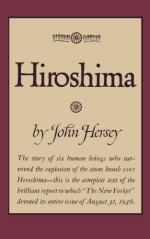|
This section contains 716 words (approx. 2 pages at 400 words per page) |

|
Hiroshima Summary & Study Guide Description
Hiroshima Summary & Study Guide includes comprehensive information and analysis to help you understand the book. This study guide contains the following sections:
This detailed literature summary also contains Topics for Discussion and a Free Quiz on Hiroshima by John Hersey.
On August 6, 1945, at 8:15 AM local time, an atomic bomb detonated over the city of Hiroshima, Japan. Estimates suggest that over 100,000 people died, tens of thousands were never recovered. Roughly ¾ of the people died within hours, most of the remainder within days or weeks. Approximately 40,000 people were injured. Nearly 80% of the city's 90,000 houses were destroyed; the heat at the point of explosion was estimated to be 6,000 C. The explosion was followed by a second atomic detonation at Nagasaki, Japan. Together, they effectively ended World War II.
The book considers the lives of six individuals and is set against the wider backdrop of the aftermath of the explosion. As originally published in 1946, the book contained four chapters. Chapter 1 related the events occurring at the moment of detonation. Chapter 2 considered the day of the explosion. Chapter 3 considered the following week. Chapter 4 discussed the following months. In 1985, the book was republished with an additional chapter. Chapter 5 considers the personal history of the six survivors from the vantage point of several decades.
Toshiko Sasaki was working as a clerk on the day of the explosion. She was immediately buried under a mountain of falling books and debris and remained buried for many hours. Her leg suffered compound fractures, and she was initially considered beyond medical assistance. For several months, she was transferred between various facilities until her leg healed without being set. After the war, she was comforted and educated by Father Wilhelm Kleinsorge. She was eventually baptized, entered a convent, and later took her vows. She subsequently lived a life of quiet and profound service to others.
Dr. Masakazu Fujii owned a private hospital that was destroyed by the explosion. He suffered from a broken clavicle and ribs and quickly retired to the countryside to recuperate. After the war, he developed a successful practice and focused on healing through the pleasure principle—always indulging his passions. In his older age, many viewed him as stubborn and withdrawn. In 1963, he hosted a party and then went to his room where—perhaps accidentally—he suffered brain injury from sleeping with a gas line running open. He spent the next approximately decade in a coma and then died.
Hatsuyo Nakamura was a widowed mother of three. They were at home when their house was destroyed by the atomic bomb. She dug her three children from the rubble, and they escaped to a park. In the subsequent years, she suffered calamitous health failures due to radiation sickness and eked out a subsistence living for her children by performing odd jobs. She eventually worked in a factory and recovered her health. Although she suffered several hospitalizations, she successfully raised a family under appalling conditions of devastation and poverty.
Father Wilhelm Kleinsorge was a priest at the mission home at the time of the detonation. He spent the next several months and years providing what service he could to others in need. After the bombing, he suffered profound health complications from radiation sickness and was hospitalized frequently, once spending an entire year under medical care. His ceaseless service garnered hundreds of baptisms and dozens of weddings. As he got older, his health continued to fail until he died under the watchful care of his friends.
Dr. Terufumi Sasaki was a surgeon at the Red Cross Hospital on the day of the detonation. He spent the ensuing days and weeks offering first aid and medical treatment to the thousands of survivors. Haunted by the images of the atomic holocaust, he eventually retired to a small community and provided medical services. His practice gained huge popularity and within several years, he was rich and prosperous, if somewhat eccentric. He also suffered health complications, including the loss of a lung due to cancer.
Reverend Kiyoshi Tanimoto was a Christian advocate who suffered little immediate physical harm from the detonation. He spent the next days and weeks in tireless service to others until nearly collapsing from exhaustion. In later life, he suffered some health complications from radiation sickness but was largely able to prosecute his goals effectively. He traveled extensively throughout the United States on several tours, garnering support for Hiroshima survivors and anti-nuclear weapon groups. Although he was later marginalized as unreliable or self-seeking, he was largely successful in his life's goals.
Read more from the Study Guide
|
This section contains 716 words (approx. 2 pages at 400 words per page) |

|



